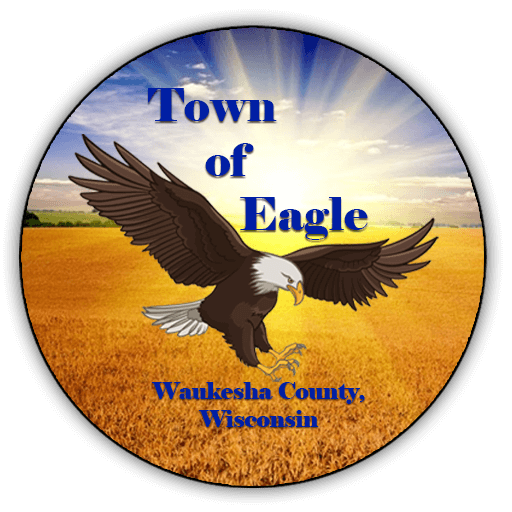Township 5, Range 17 East, was first organized into a precinct separate from and independent of adjoining towns, in accordance with act of the Council and House of Representatives of the Territory of Wisconsin, January 12, 1841. Up to 1839, Eagle was part of Mukwonago; then a part of Genesee up to the passage of the above act. The first town meeting was held at the house of Andrew Scofield, in Eagleville. However, it is impossible to be strictly accurate in the earliest details, owing to the fact that the first town records were lost, so far as ascertainable.
The town received its name in a rather singular manner, as follows: In the year 1836, while Thomas Sugden, John Coats and a Mr. Garton were prospecting, they came to a beautiful prairie about one and a half miles in area. Here, hovering and curving over a large mound, near the present residence of Ebenezer Thomas, was a monster bald-headed eagle. From this incident and time, the prairie and town were called Eagle.
The country, in its natural state, was diversified by springs, brooks, marshes, prairie and burr oak openings. The arable soil was slightly variable in composition, being, for the most part, a rich loam and gravel, and was quite productive. A chain of bluffs passed through the northwest part, but the greater part of the land was tillable. Here, as elsewhere in the county, the inhabitants suffered the deprivations incident to pioneer life, which became the subjects for many an evening tale.
The first claim is said to have been made by A.R. Hinkley on Eagle Prairie, on the 20th of September, 1836, where he erected a shanty. He brought his family here in 1838, and in space 12x16 feet, put up two beds, a pine table, a rotating-top stove, four chairs or stools, a large box for bedding, five barrels of flour and one or pork. This single experience but illustrates the trials and inconveniences to which all were subject.
In 1836, Eb Thomas and wife came and erected a house on their claim and occupied it. They were actually the first permanent settlers. The year following, Mr. Thomas started a blacksmith shop, the first in the town.
Charles Sherman was the first born in the town, and his people were among the very first settlers.
In 1837, Jerry Parsons built the first regular hotel called Jericho. Jericho took its name from the first syllables of Parsons’ given name and the Bible name. Jericho had also at one time had two stores.
In the fall and winter of 1836, the first saw mill in the town was built at the place called Eagleville by Daniel Bigelow, one of the first pioneer millers of the state. The following year, he erected a grist-mill which crushed grain for the early settlers. For years, this was the only grist-mill in the county. The mill of A. Schofield was built in its place in 1844. The first store at Eagleville was started by Mr. Schofield in 1844. By this time, the town had become of sufficient importance to require a post office and Mr. Schofield became the first Postmaster. The railroad came along in 1851.
The first school is said to have been taught by Miss Gertrude Goodrich, in a small building near Jericho, in 1840.
The Methodist Episcopal Church was the first church that held regular services and had a Sunday school which was held in the settlers’ houses until the erection of the schoolhouse of District No. 1 in 1841.
Cheese manufacturing began in the town in 1875. The factory had a capacity for handling 10,000 pounds of milk per day. In connection with the factory, there was a fifteen-horsepower engine which ran a log-sawing apparatus, a planning and feed mill.
William Harrison kept the first store in Eagle in 1842 at the place called Palestine. At hotel was also kept there a few years later, and the blacksmith shop of Charles Raynous.
The first wagon-maker was Henry James in 1843. In 1844, the town saw the first shoemaker, Seneen Harris, first tailor, Robert Clark, and the first tavern, kept by Isaac Severaoce.
J.C. Snover
- R. Hinkley
- T. Walkin
The History of Waukesha County Wisconsin. 1880. Chicago: Western Historical Company MDCCCLXXX
https://archive.org/details/cu31924028871627/page/n5

